South Australian growers slam PIRSA response to tomato brown rugose fruit virus
Millions of dollars worth of tomatoes are being trucked to landfill as the heartbreaking toll of a contagious new virus continues to rise. Here’s how the devastated farmers are coping. See the video.
SA News
Don't miss out on the headlines from SA News. Followed categories will be added to My News.
Tomato growers crippled by an infectious virus threatening their industry have blasted the “soul-destroying” national response as inept, ill-informed and a massive over-reaction.
Adelaide Plains growers Perfection Fresh, SA Tomato and Gawler River Tomatoes have destroyed millions of dollars worth of produce since being quarantined after tomato brown rugose fruit virus was detected on their properties.
The growers are out of pocket millions more dollars in lost revenue and say the response from the SA Primary Industries and Regions Department (PIRSA) and a national response committee has been over the top.
“The government set out to protect the industry, but in return, they’ve actually crippled the industry,” SA Tomato owner Peter Petsios told the Sunday Mail.
“They’ve actually caused more damage than what they set out to save. Everyone’s scared. There’s a glut of tomatoes in the market. They can’t even sell them. People can’t transport food around. They’ve just freaked everybody out. In my opinion, it’s a storm in a teacup.”

SA Tomato was shut down on August 16 and Mr Petsios, who has run the business his father started in 1960 for decades, and his wife Oriana were forced to destroy $1.3m worth of tomato plants.
Mr Petsios said the decision to close down the three businesses was disproportionate and ill-informed, and would cost taxpayers millions of dollars in compensation.
The virus, which damages plants and fruit but has no known effects on humans, was reported in Australia for the first time after a positive test from plants in a Perfect Fresh glasshouse in Two Wells in August.
General manager Matthew Fergusson compared the response to the start of the Covid-19 pandemic, when authorities panicked and attempted an eradication strategy rather than containment.
“We’re dealing with this as if eradication is the only option, but it’s near on impossible,” Mr Fergusson said. “This disease exists around the world, and seeds come into Australia, potentially with the virus attached to them.”
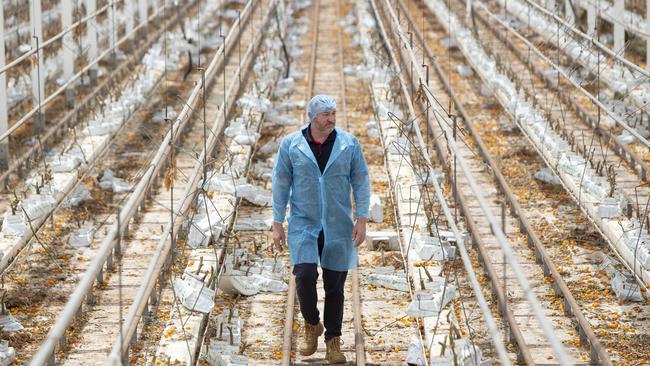
Mr Fergusson said the process of destroying more than 1.2m plants to comply with PIRSA directions was soul-destroying.
The growers said overseas colleagues, who had managed outbreaks of the virus since it emerged from the Middle East a decade ago, were astounded to hear the harshness of the Australian response.
The property of Virginia tomato and capsicum grower Emmanual Cafcakis has not been infected, but he agreed the response was inept and over the top.
PIRSA director of plant and invasive species Nick Secomb defended the handling of the crisis, and said decisions were made at a national level with the best interests of the industry, worth $230m in SA and $800m nationally, at heart.
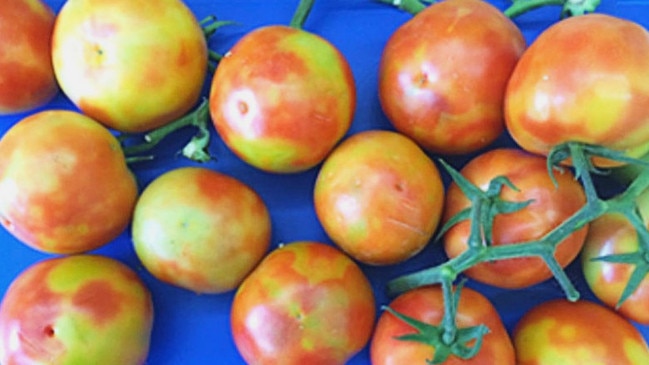
“I understand that overseas, other countries, manage it differently, but that’s because they have to … it is established (there),” Mr Secomb said.
“They don’t have the opportunity that we have had here to isolate it, contain it and consider eradication.
“I understand the point of view of the growers, and I hear that some growers have been affected … but nationally, we have to look at what’s in the best interest of the entire industry.”
Mr Secomb said a national committee agreed on Thusday to a series of steps the three quarantined farms could follow on their path back into the industry.
INSIDE STORY: HOW THINGS TURNED ROTTEN FOR OUR TOMATO FARMERS
By Paul Ashenden
The heat is oppressive here at ground zero.
We’re in a huge glasshouse on Adelaide’s northern flood plains and should be surrounded by a lush forest of tomatoes and an army of workers removing succulent, red fruit from the vines.
Instead, it’s a barren un-airconditioned wasteland of row after row of concrete, plastic, wires, lights, metal and glass.
The temperature hovers around 50C and sweat pours down our faces as we take in the desolate scene of a $100m piece of horticulture infrastructure going to waste.
We’re in Glasshouse 13 at Perfection Fresh in Two Wells. It’s one of 31 glasshouses on the 43 hectare horticulture farm. This is one of the biggest tomato farms in Australia but there’s not a roma, cherry, truss or heirloom in sight.
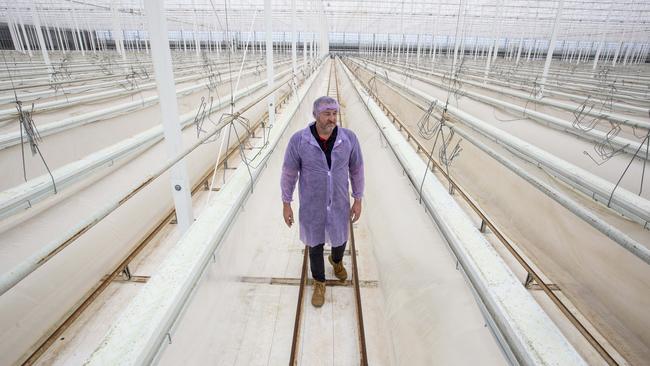
Here, in Glasshouse 13, is where the world turned upside down for the hundreds of South Australia tomato producers and the future of an industry worth $800m to Australia’s economy was thrown into disarray. This is where they discovered the nation’s first-ever presence of the tomato brown rugose fruit virus.
Back in July, this glasshouse was heaving with tomato plants. But amid the lush greenery, staff noticed a few plants that looked slightly off-colour. They were worried it might have been the virus that first emerged in the Middle East more than a decade ago but had never before been found in Australia. Also known by the acronym ToBRFV, the virus can’t harm humans but is highly contagious and can damage tomato, capsicum and chilli crops.
So the growers at Perfection Fresh did the right thing and sent off samples to a lab in the Netherlands for testing. A few days later, an email lobbed in their inbox confirming their fears.
But the results didn’t throw the growers and management at Perfection Fresh into a panic.
They take hygiene seriously here and have strict protocols for dealing with viruses and disease. They removed the sick plants and hundreds of nearby healthy ones and set them aside for incineration. They restricted workers moving between glasshouses in an effort to contain the virus.
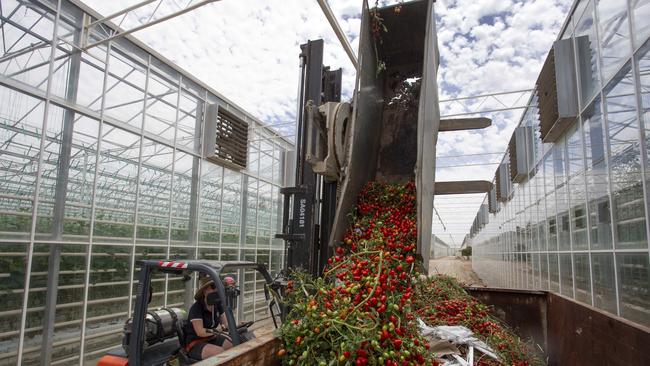
And they reported the results of the Dutch lab to the biosecurity division of the Department of Primary Industries and Regions, PIRSA.
And that’s when things for the $230m SA tomato industry suddenly turned rotten (pardon the pun).
***
Officials from PIRSA, working in conjunction with a national consultative committee, came down hard. They placed Perfection Fresh’s 31 glasshouses in quarantine and now, three months later, the few remaining workers on the farm are still working through the process of destroying more than 1.2 million plants. The farm is out of pocket tens of millions of dollars.
“It’s heartbreaking,” general manager Mathew Fergusson says as we check out another glasshouse still teeming with tomatoes.
“The people effort to get these crops where they are is enormous. The expense to get the crops where they are is enormous.
“You’re looking at hundreds of thousands of dollars of plants in this glasshouse alone that we’ve planted but we don’t even know if we can bring them to fruition and sell fruit.
“Our team’s doing a super job to just stay calm and keep focused on doing what we can do best to get through it. But it’s heartbreaking. It’s absolutely soul destroying.
“This is what we’re doing every day – just in the bin, in the bin, in the bin … It’s just terrible.”
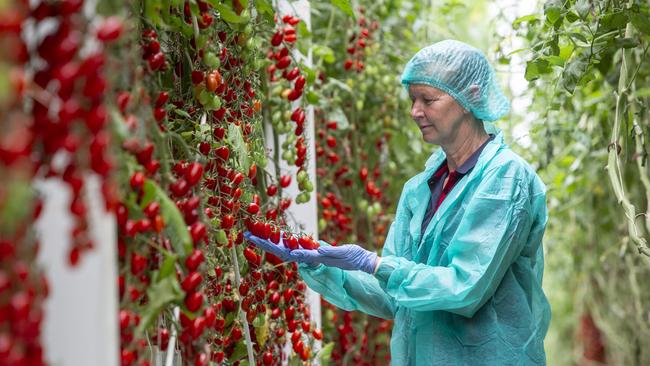
The plants in this greenhouse are heavy with tomatoes. Staff have kept them alive on the off-chance PIRSA might lift the quarantine imposed on the farm back in August.
We sample a few as we walk and talk. They’re red, juicy and delicious. But they’re probably destined for landfill.
This greenhouse, 9B, was full of cucumbers when ToBRFV was discovered in Glasshouse 13. Hence it wasn’t tested for the virus at the time and after the cucumbers were harvested it was filled with pre-germinated tomato plants.
PIRSA officials took samples from 9B for testing on October 23 and November 4 but when Sunday Mail visited on Thursday, nearly a month after the first tests, they were yet to inform Perfection Fresh of the results.
Mr Fergusson says Perfection Fresh scientists can turn around ToBRFV tests in 90 minutes.
The quarantine restrictions at Perfection Fresh mean the farm is now running on skeleton staff. There would normally be 1000 or so people working here at this time of year. Today, Mr Fergusson reckons there’s only 200 or 300.

Annette Pulbrook, Perfection Fresh’s regional workplace health safety and environment manager, says a meeting in August at which hundreds of workers were told they would be out of a job was one of the toughest moments in her career.
“It was just heartbreaking seeing people’s faces when they realised what was going on … and there was nothing we could do about it,” she says.
“We weren’t at fault here. We did not bring these seeds in on purpose. We did the right thing. We told PIRSA that we had it.
“They did their investigations, and this is what happens. Why would anyone do the right thing?”
***
It’s a question also posed a few kilometres down the road at SA Tomato, just out of Virginia, where Peter and Oriana Petsios have been pioneers in hydroponic industry for decades.
SA Tomato specialises in grafting high-performing plants to growers across Australia. It’s a delicate, hi-tech process which starts from imported seeds and involves combining the root stock of one seedling with the head stock of another to create a supercharged tomato maker.
No-one in Australia sells tomato seeds, so they must be imported. The seeds go through a quarantine process before they enter the country, but any tested seed is unusable, which means only a small proportion of each shipment can be tested.
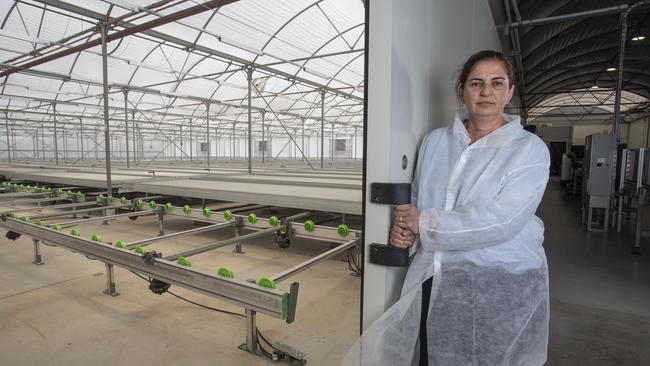
Mr and Mrs Petsios propagated the plants that Perfection Fresh flagged to PIRSA and hence, when the authority shut down their clients, their own family business, started by Mr Petsios’s father when he migrated from Greece in 1960, was also placed in quarantine.
That was more than 90 days ago, and the Petsioses have been without an income ever since. They disposed of $1.3m worth of produce and their banks are warning they might need to sell their house if they can’t get back into the market soon.
A specialised machine worth $5m, that is costing $140,000 a month in repayments, lies dormant and a 5000-square metre greenhouse that should be filled with 100,000 plants is empty. They’ve sent most of their 25 or so staff home on annual leave.
Mr Petsios says the PIRSA and national response to the virus is an over-reaction, and is angry he is likely to lose millions of dollars because of something outside of his control.
“What the hell did I do wrong?” he asks as we chat in his office.
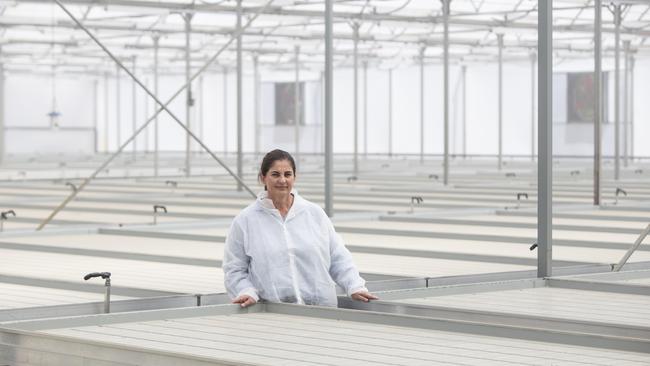
“They should have removed those (infected) plants, spray the place down, and put us back to work the next day. That would have been the logical response.
“We know exactly how to handle viruses. We live with these viruses every day of our lives, and we understand them.
“We can see them when they become apparent. We scout for them, we manage insects, fungus, mildews and stuff like that all the time.
“That’s part of the business, that’s what we do. It’s in the grower’s best interest to take that (viruses) much more seriously than the government because his livelihood is at stake.”
Mr Petsios likens their situation to a bus operator who picks up a patient suffering from a virus. In his analogy, the driver cleans the bus, but three months later is still not allowed to pick up any passengers.
***
The Cafcakis family grow tomato and capsicum on the other side of Virginia and their farm, as a client of SA Tomato, has also been under close scrutiny of biosecurity inspectors.
Emmanuel Cafcakis says he waited seven weeks for PIRSA to clear his farm from the virus and reckons he’s lost more than $100,000 throughout the saga.
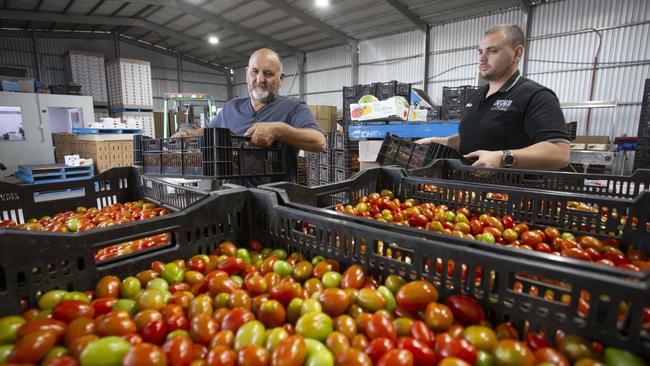
He’s frustrated that Queensland and WA were allowed to shut their borders to SA growers, leaving a glut in the market in the other states, so that profits have plummeted even for growers cleared of ToBRFV.
Like the others, Mr Cafcakis is furious at the heavy-handed approach taken by authorities, and points to overseas jurisdictions where even infected properties are allowed to continue selling fruit.
And he worries the approach will scare off producers from reporting any future cases of the virus.

“We deal with viruses and diseases all the time, let us deal with it,” he says passionately.
“All this has done is forced us under the table. Because any grower all over Australia, if they suspect something, they’re not going to go (and tell authorities): ‘I think I’ve got a virus’.
“Because they’re going to go and devastate them and shut them down. They’re (growers) going to shut up. No one’s going to admit to it.
“This is a typical bloody Covid response – learn to live with it.”





